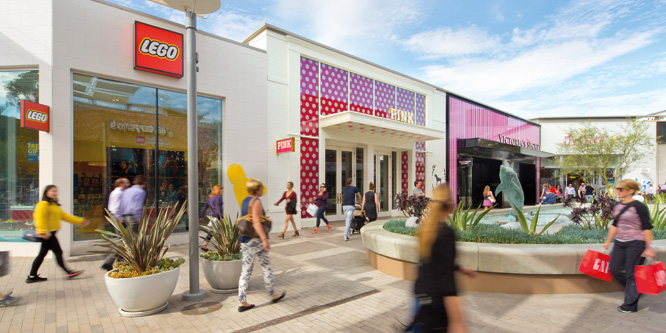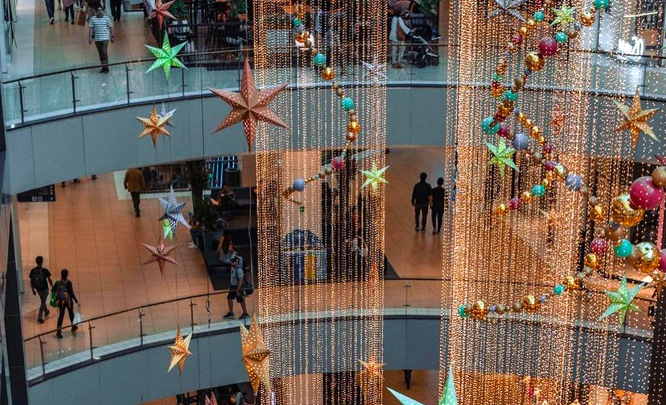
Photo: Westfield
For relevancy’s sake: a tale of two mall upgrades
Developers have a big stake in reinventing the shopping experience. Shopping center companies and mall operators around the world are upgrading properties to appeal to today’s shoppers. Here’s a tale of two cities’ centers:
I recently visited the Costanera Center in Santiago, Chile, the largest mall and highest observatory in Latin America. It offers many of the upmarket global brands one would expect. It also features hospitality and entertainment establishments, including dining, cinemas and a 360-degree view of Santiago and the Andes.

But what I really loved about the center was that its 300+ stores were organized thematically by floors. Gifts were on the first floor, women’s on the second floor, sporting goods on the fourth floor, etc. This makes it so easy for visitors to find their way around, browse and buy exactly the right merchandise — in my case, souvenir local football apparel, Chilean wine and spices. It’s such a smart strategy to group related merchandise by location, especially given that it’s a really large property. And I expect that this layout improves overall experience, navigation and conversion for visitors as well as regular, local shoppers.
At home in San Diego, the Westfield University Town Center (UTC), originally opened in 1977, is just finishing up a major renovation. UTC took a multi-year, multi-prong strategy in its approach to freshen up. There is a revamped anchor (Nordstrom), new boutique brands, inviting and comfortable common spaces in which one can relax, and lots of dining options. Nearly everyone I know is most excited about the new hospitality destinations, making a special trip to UTC to dine, and as practically an after-thought, walking through to see what new specialty brands are making their local debut.
The crowds at both of these locations show that while retailers and brands can’t forget the basics — interesting products and high-quality service — operators in both hemispheres are updating their recipes. It was great to see excitement injected into properties through better curating shopping patterns, refreshing assortments and attention-grabbing hospitality and entertainment options.
Discussion Questions
DISCUSSION QUESTIONS: Given consumers’ mandate for variety, comfort, entertainment and excitement, what are the best strategies and tactics for drawing traffic to malls today? Do you think thematically-organized merchandise floors or areas in U.S. malls would be successful?


Many retailers we saw at NRF/in NYC are running their Flagship stores as event centers. Nike, Dyson and Microsoft are great examples. And malls need to do the same. Make these experience centers, as you articulate above. Think West Edmonton Mall … with an entire amusement park within it. Draw in customers for the experience and sell them a few items while they are there.
Consumers will I love the idea. It makes shopping easier and provides more quick variety. It makes it easy to cross check items between stores. Not great from the retailer’s perspective, but it could draw in more customers — if the mall is an efficient way to check out several stores for the item the consumer wants.
Tenant category planning is an effective measure, but does it ultimately encourage visitor traffic? And does it increase the spontaneous purchase of other categories (food and beverage is one) while shopping in, say, the women’s apparel area?
Last week I noticed on the ICSC Twitter page that retail developer Vestar has entered into a partnership with Lyft to share in ride revenues and provide promotional rates to and from their properties. If the consumer can get a discounted ride to/from their local Simon, GGP, or Westfield shopping center – that is a start.
Interesting point about Lyft – I failed to mention that UTC has installed parking gates and later this year will be charging visitors for parking. Makes me less inclined to go to a shopping center unless I have a specific goal in mind (dining, need something I can’t get delivered, meeting, etc).
Lots of ways to inspire and underwhelm visitors!
First, thank you for the glimpse into Santiago, Chile. I wasn’t planning on being in that neighborhood any time soon. Sounds great! As far as planned content by floor — doesn’t get my vote. I rather like the variety and texture of “treasure hunt” shopping. And I like the way you have highlighted the roles that both the mall and the individual stores have in creating that treasure hunt environment. Macro AND micro. What’s my reason for returning to the mall? Because I KNOW that I’m going to encounter a fun, new entertaining UNKNOWN.
Baby it’s cold outside! Renovation can be approached in a variety of ways and none have to be more right or more wrong. In the case of thematic location, I fear that some business may be on the fringe of two and get misplaced or not found. There is also the possibility of having arch competitors side by side (good for the consumer, not so good for the retailers).
UTC (which I visited in mid-2017, during its renovation) is an object lesson to regional malls all over the country. You don’t need to be a “zombie mall” (with two shuttered anchors and a J.C. Penney in the middle) to face the challenge and opportunity of reinvention. Props to Westfield for recognizing this.
But it’s important to get every tenant up to speed at the same time. When I visited UTC, the new Nordstrom location was under construction, but the Macy’s anchor was badly in need of a remodel. (Even some fresh paint and new carpet would have helped.) Maybe its issues have been addressed in the past 18 months, but it points out how one tired department store can affect the best intentions of the mall developer.
Hey Dick – UTC is giving best efforts to be a ‘destination’ with the common areas and the dining being top attractions, despite the on-going construction. Macy’s is working on upping it’s game but has a long way to go!
In-mall, as with in-store, experiences must be more than theater, they must be relevant and useful to their consumers. Examples include:
Poorly conceived experiences, however, will continue to proliferate at retailers who just can’t see the goal line. Compare the winning models above with feeble attempts at relevance via barber shops, espresso bars, pool tables, and photo ops.
And then there’s Amazon 4-star… the odd mix of brands, products and cashier-less shopping is designed around data collection rather than customer experience. I anticipate that Amazon’s human and artificial intelligence will make these stores more consumer-centric over time.
It was useful to this customer to actually buy something without getting all my 10K steps while searching 🙂
I couldn’t agree more, Patricia, that malls still have a very strong place in today’s shopper landscape. The challenge is breaking out of the traditional anchor store strategy and creating more of a destination theme as you describe.
I think everyone is aware of the need to give people a reason to visit physical spaces and malls are no exception. The right mix of events and other entertainment options like F&B, bars, experiences, fitness and wellness, etc is just as important as the right mix of retailers and brands.
Thematically organised merchanised floors/areas is an interesting idea. Perhaps you don’t want it for every category, but there are a few examples out there now of malls/shopping centres with areas given over to formerly online-only retailers and/or pop-ups. It’s making those parts of these spaces somewhere customers know where they’ll always have something new to discover and a fresher shopping experience overall.
The right recipe for malls and shopping centers is still emerging, and there certainly needs to be freshness in offerings to drive excitement and traffic. I think it can be supplemented with easier-to-shop layout where shoppers can more readily locate, research, experience (and buy) merchandise.
We just did research on this topic and what struck us was the importance of food offerings in bringing customers back to spaces they’ve chose to abandon. BUT … not a food court or an old restaurant, they wanted to see a “food hall” and a “farmer’s market” and a “modern grocery store,” etc — i.e. updated, relevant food offerings. We talked to 4000 people across all age groups and those were paramount.
Also high on the list were “work spaces” (like WeWork) and fitness centers as well as sports facilities. You know, selling and doing spots, not just shopping rows of stores.
But the biggest factor of all was that young people (under 29) wanted to see the whole shopping area (mall/strip center/town center, etc) change to the more relevant concepts we showed them. So, malls (etc) cannot continue to offer row after row of specialty apparel as they have for the past 40 years. The new customer wants a new mall. Or it’s Amazon time, which in fact, IS a new kind of mall — the easiest kind.
This is a discussion that’s been in play for at least a few years as the shopping habits of consumers have changed to include much more online shopping. So, malls have to have more reasons for people to visit, and building out entertainment venues (theaters, dining, special attractions, experiences, etc.) seems to be a way to get people to the mall.
The big question has been whether or not getting people to the mall increases retail traffic and sales. The short answer seems to be yes, but is the increase enough? And, the ever-changing consumer habits are forcing malls to stay at the top of their marketing game. Thematically organized merchandise floors are convenient to a point.
Wondering where the specialty store belongs could throw off the theme.
Still, I like the way malls and retailers are thinking. They are working hard to enhance the customer’s experience. If they want to succeed they will have to make the changes necessary to win the hearts and dollars of their customers.